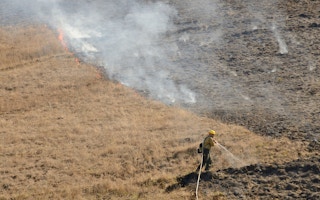It’s official: 2014 was the world’s hottest year on record. And it’s part of a decades-long trend. If you’re under 30 years old, global temperatures have been above average your whole life.
This long-running record heat contributes to an expensive “new normal” for global businesses and national economies, raising the cost due to shifting weather patterns and more extreme heat waves, storms and droughts that can be fueled by a changing climate. 2014 was not just the hottest year on record globally, but the world also experienced record-high seasonal temperatures in the summer and fall, and the second-warmest spring.
The World Economic Forum’s Global Risks report shows that leaders increasingly see these phenomena as a major drag on their bottom lines, ranking severe weather events and water crises among the top 10 likeliest global risks, and the risks expected to have the most impact in 2015.
Neeraj Sahai, president of Standard & Poor’s Ratings Services, put it this way in Fortune magazine: “The investment community—along with regulators—has woken up to this threat. It is demanding more information from companies about their exposure to climate events, as well as the prospective cost of their carbon emissions.”
This awakening has impact across the U.S. political spectrum. Former Republican New York City Mayor Michael Bloomberg, former Treasury Secretary Henry Paulson and Tom Steyer, a billionaire hedge-fund manager and Democratic donor joined together last year to oversee an important report on the economic impact of climate change, Risky Business: A Climate Risk Assessment for the United States. This report showed U.S. businesses and the economy were vulnerable to sea-level rise — with up to $106 billion worth of existing coastal property likely to be below sea level by 2050—and extreme heat, which is expected to threaten 50 to 70 per cent of average annual crop yields in some states by 2100.
“
This long-running record heat contributes to an expensive “new normal” for global businesses and national economies, raising the cost due to shifting weather patterns and more extreme heat waves, storms and droughts that can be fueled by a changing climate.
The signs of extreme temperatures in 2014 were clear and global. In Europe, the heat wasn’t simply record-breaking, it was made at least 35 times more likely by human-made climate change. In Brazil, the city of São Paulo had its historic drought. In the United States, record warmth amplified the effects of damaging drought in California, Arizona and Nevada.
This long-running warming trend comes at a time of increasing costly weather and climate events. From 1980 to 2014, there were 178 such events in the United States that each cost $1 billion or more, for a total of more than $1 trillion. These expensive events have increased worldwide over the same period, with seven of the 10 costliest years of weather and climate disasters occurring since 2000.
Multi-national corporations are counting the cost, as shown in areport from CDP (formerly Carbon Disclosure Project), highlighting corporate climate risk disclosures from 2011-2013:
- HP experienced a 7 per cent decline in quarterly revenues in large part attributed to the 2011 floods in Thailand.
- Gap, Inc. had higher material costs for cotton due to changes in precipitation and drought in China;
- Dr. Pepper Snapple Group, Inc. found the potential change in weather, climate and water availability put $2.5 billion of their cost of sales at risk;
In the face of these recognized climate risks, what can businesses and policy-makers do to make themselves, their customers and their communities more resilient?
Integrating climate adaptation into core strategic business planning is one practical step, as detailed in Adapting for a Green Economy, a report from the UN Global Compact, UN Environment Programme, Oxfam, and WRI. Some companies, like Coca-Cola, have identified core business inputs—such as water—that face increasing risk in a changing climate. The company is now requiring water assessments across more than 800 bottling plants and investing in communities to ensure long-term supplies of safe drinking water.
But businesses can do more than invest in adaptation. Their actions should match their rhetoric on environmental sustainability and climate resilience, and so far, that remains elusive. New research from Thomson Reuters Sustainability and BSD Consulting showed that greenhouse gas emissions by the world’s top 500 companies rose 3.1 per cent from 2010 to 2013, well short of what scientists urged to limit the worst consequences of global warming.
Companies can benefit by reconciling the difference between climate risks and the actions needed to lessen those risks. To do that, traditional approaches won’t be enough. More companies should set emissions reduction targets in line with the best science. Business should also work to advance policies, especially through industry associations, that demonstrate that they are serious about hitting their emissions targets, since they can play a key role in keeping global mean temperatures below the two degrees Celsius (3.6 degree F) threshold.
Businesses—particularly consumer-facing businesses—can leverage their brands to engage customers, stakeholders and the public at large on climate change. Opponents have a long, successful history of styling climate action, including putting a price on carbon, as being bad for the economy or costing jobs. Yet, the sweeping New Climate Economy Report shows this is simply incorrect, and that climate action can bring economic benefits. By urging governments and other stakeholders to enact responsible policies on climate, multi-national corporations can help shift public perception away from the false dichotomy of “environment vs. economy” and create the political conditions for progress.
Manish Bapna is the executive vice president and managing director of the World Resources Institute, and Forbes Tompkins is a Research Analyst in WRI’s Climate and Energy Program. This post is republished from WRI’s Insights blog.











